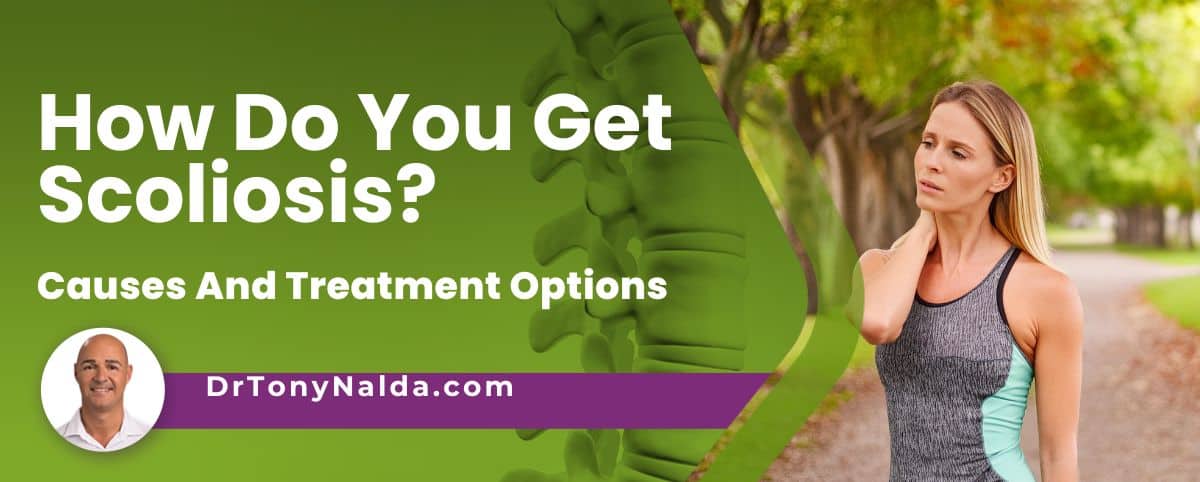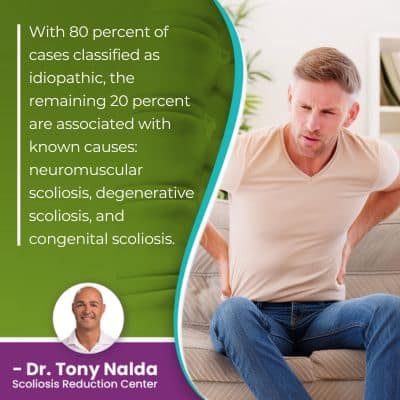How Do You Get Scoliosis? Causes And Treatment Options

Most people with scoliosis have idiopathic scoliosis: not clearly associated with a single-known cause. Idiopathic scoliosis is considered multifactorial, meaning caused by a combination of variables that can vary from person to person, and there are atypical types with known causes.
There are different types and severity levels of scoliosis, and type is determined by causation. In most cases of scoliosis, the cause is unknown, but in some atypical types, scoliosis has known causes that are neuromuscular, degenerative, or congenital.
What triggers scoliosis to develop will vary based on the condition type in question, so let's start with the most common types of scoliosis and their causes.
Table of Contents
Different Types of Scoliosis: Causation
Developing scoliosis means an unnatural sideways curve of the spine has developed, and in addition to bending unnaturally to the side, it will also twist, and this rotational component is what makes scoliosis a 3-dimensional condition.
The complex nature of scoliosis necessitates the complete customization of potentially-effective treatment plans, and that is because no two cases of scoliosis are the same.
Not only does scoliosis have different types determined by their underlying causes, the condition also ranges in severity from mild scoliosis to moderate scoliosis, severe and very severe scoliosis.
Scoliosis also affects all ages and can develop anywhere along the spine; there are three main spinal sections consisting of the cervical spine (neck), the thoracic spine (middle/upper back), and the lumbar spine (lower back).
Different types of scoliosis have different characteristics and treatment needs.
The main type of scoliosis to affect all ages is idiopathic scoliosis, so let's start there.
Idiopathic Scoliosis
When scoliosis is first diagnosed, part of the process involves further classifying conditions based on key patient/condition variables, and these factors are what shape the design of treatment plans.
Approximately 80 percent of known diagnosed cases are classified as idiopathic scoliosis, meaning cause unknown, and idiopathic scoliosis is the most common type to affect all ages.
When it comes to treating idiopathic scoliosis, a conservative chiropractic-centered treatment approach involves integrating multiple scoliosis-specific treatment disciplines so conditions can be impacted on every level: chiropractic adjustments to reduce the curve, physical therapy to increase core muscles strength so the spine is optimally supported by its surrounding muscles, corrective bracing to push the spine into a corrective position, and rehabilitation to further heal and stabilize the spine.
As growth is the condition's trigger for progression, childhood scoliosis should always be taken seriously, and treatment has to work towards counteracting the constant trigger of growth through a significant curvature reduction.
The most-prevalent type of scoliosis overall is adolescent idiopathic scoliosis, diagnosed between the ages of 10 and 18, and what many people with scoliosis want to know is if idiopathic scoliosis is genetic, and the fact that having scoliosis in the family is considered a risk factor does make the question valid.
Is Scoliosis Genetic?
Scoliosis, however, is considered more familial than genetic, and this is because despite the years of research dedicated to identifying a single gene, or genetic mutation, that accounts for the development of idiopathic scoliosis, it has yet to be found.
So why is having a family history of scoliosis considered a risk factor? Because families share a lot more than just their genes; they share socioeconomic factors, geography, body type, diet, lifestyle, responses to stress, posture, and more.
Idiopathic scoliosis diagnosed and treated early can be highly treatable because these cases are considered typical and involve right-bending curves that bend away from the heart, but in atypical types with known causes, curves can be left-bending because there is an underlying pathology.
Typical cases of idiopathic scoliosis can be treated with a surgical or nonsurgical response, and nonsurgical treatment is what patients of the Scoliosis Reduction Center benefit from.
Conservative nonsurgical treatment is integrative, so patients benefit from what multiple scoliosis-specific treatment disciplines have to offer, including chiropractic care, physical therapy, corrective bracing, and rehabilitation.
 With 80 percent of cases classified as idiopathic, the remaining 20 percent are associated with known causes: neuromuscular scoliosis, degenerative scoliosis, and congenital scoliosis.
With 80 percent of cases classified as idiopathic, the remaining 20 percent are associated with known causes: neuromuscular scoliosis, degenerative scoliosis, and congenital scoliosis.
Neuromuscular Scoliosis
In cases of neuromuscular scoliosis (NMS), the scoliosis is caused by the presence of a larger neuromuscular condition such as spina bifida, cerebral palsy, and muscular dystrophy.
Neuromuscular scoliosis involves a disconnect between the brain and the muscles/connective tissues that support the spine, disrupting its ability to maintain its natural curves and alignment.
My neuromuscular scoliosis patients are among the most complex to treat because it's the condition's underlying cause, the neuromuscular disease, that has to be the focus of treatment, and this complicates the process.
Cases of neuromuscular scoliosis tend to be severe and can involve patients becoming wheelchair bound and unable to move around unassisted.
Treatment options for neuromuscular scoliosis are driven by the larger neuromuscular condition because the scoliosis has developed as a secondary complication, so I can't offer my NMS patients the same types of prognoses as I can with my typical idiopathic scoliosis patients, but in most cases, improvements can be worked towards to improve a patient's overall quality of life.
Conservative treatment for NMS patients can involve chiropractic adjustments to increase spinal flexibility and physical therapy to increase core strength.
Degenerative Scoliosis
Degenerative scoliosis is caused by natural age-related spinal degeneration so affects older adults, and is also more common in females due to changes in bone density and hormones related to menopause.
There is a certain amount of spinal degeneration to be expected with age, and the cumulative effect of certain lifestyle factors also play a role in the level and rate of degenerative changes in the spine.
Carrying excess weight, leading a sedentary lifestyle, chronic poor posture, repeatedly lifting heavy objects incorrectly, and excessive consumption of alcohol and/or smoking can increase a person's natural rate of degenerative changes.
Most spinal degeneration starts with the intervertebral discs; the spine consists of vertebrae (bones) stacked on top of one another, and adjacent vertebral bodies are separated by a spinal disc that performs many key roles: acting as the spine's shock absorbers, giving the spine structure (adjacent vertebrae attach to the disc in between), making the spine more flexible, and providing cushioning to prevent friction during movement.
Degenerative disc disease is a contributing factor in the development of a number of spinal conditions because once a disc starts to degenerate and changes shape as a result, it affects the position of adjacent vertebrae, and the disc's general surroundings.
 Once the spine starts to degenerate, it becomes increasingly unbalanced and unstable, and this makes it vulnerable to the development of an unnatural spinal curve: scoliosis.
Once the spine starts to degenerate, it becomes increasingly unbalanced and unstable, and this makes it vulnerable to the development of an unnatural spinal curve: scoliosis.
Conservative treatment options for degenerative scoliosis focus on stabilizing the spine, pain management, and reducing the size of the scoliotic curve back to where it was prior to becoming painful.
Congenital Scoliosis
Congenital scoliosis is a rare form affecting approximately 1 in 10,000, and this condition type is caused by a malformed spine that develops in utero so babies are born with the condition.
Many babies born with congenital scoliosis present with additional congenital abnormalities so need to be comprehensively assessed and monitored, particularly during growth.
Spinal malformations can involve vertebral bodies failing to separate and form into distinct bones, instead becoming fused together and causing the spine to wedge forward at an unnatural angle, causing an unnatural spinal curve and twist to develop.
If one or more vertebrae are misshapen, this can mean they are more triangular than rectangular, as they should be, and this can cause the spine to form out of alignment.
Treatment options for congenital scoliosis will depend on how the condition responds to growth, and while treatment plans can be modified, there are obvious challenges to addressing scoliosis at such a young age.
Physical therapy and chiropractic care can help work towards reducing the size of a scoliotic curve as a child grows, and in severe cases, surgical treatment can be recommended.
Conclusion
So how you get scoliosis will depend on the type in question, and in the majority of cases, we don't know what triggers the initial onset of idiopathic scoliosis, but we do know what triggers progression: growth.
Scoliosis progressing means the size of the unnatural spinal curve is getting larger, and the condition is becoming more severe, along with its effects.
In child's scoliosis, the main symptoms involve postural changes (uneven shoulders, uneven shoulder blades, uneven hips, the development of a rib cage arch), and in adults, as the condition becomes compressive once skeletal maturity has been reached, pain is the main symptom of scoliosis.
Scoliosis with known causes includes neuromuscular, degenerative, and congenital scoliosis, and these cases are considered atypical so have unique treatment needs.
When it comes to a proactive conservative treatment approach, this is what patients of the Center benefit from.
When given a scoliosis diagnosis, whether the cause is known or unknown, what's most important is how that diagnosis is responded to with treatment, and traditional treatment tends to funnel patients towards invasive spinal fusion surgery, while conservative treatment offers a less-invasive treatment alternative.
How a patient chooses to address their scoliosis will have long-term effects because scoliosis treatment isn't about reaching a fixed point; it's about managing a life-long condition for the best possible quality of life.
Dr. Tony Nalda
DOCTOR OF CHIROPRACTIC
After receiving an undergraduate degree in psychology and his Doctorate of Chiropractic from Life University, Dr. Nalda settled in Celebration, Florida and proceeded to build one of Central Florida’s most successful chiropractic clinics.
His experience with patients suffering from scoliosis, and the confusion and frustration they faced, led him to seek a specialty in scoliosis care. In 2006 he completed his Intensive Care Certification from CLEAR Institute, a leading scoliosis educational and certification center.
About Dr. Tony Nalda
 Ready to explore scoliosis treatment? Contact Us Now
Ready to explore scoliosis treatment? Contact Us Now





